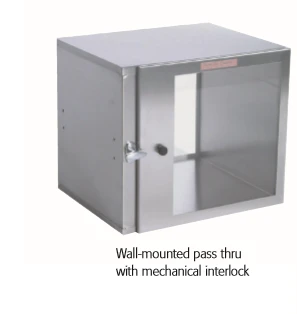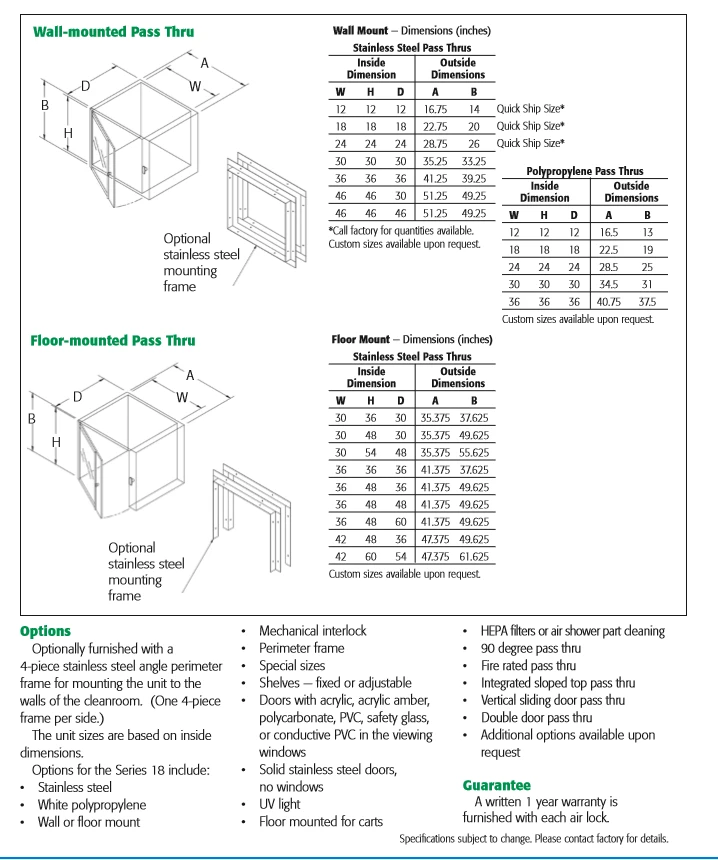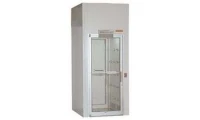Pass Thru Air Lock Cleanroom Entry System
Pass Thru Air Lock Cleanroom Entry System
Pass thru air locks are for the transfer of parts and equipment in and out of a cleanroom. They reduce the need for people to enter the cleanroom. Contamination is eliminated because of the reduced traffic within the cleanroom. Clean Air Products’ Series 18 features polypropylene or stainless steel construction — not particle board.

The Series 18 pass thru air locks are manufactured using two types of materials: white polypropylene and stainless steel. The polypropylene units are constructed of 1/2-in. white sheets that are welded together. Polypropylene is a solid plastic that contains no particle board and is a superior construction material. Pass thru cabinets made with laminated formica over particle board construction can crack, chip, delaminate, and promote the growth of biological contamination. The Series 18 uses solid poly-propylene sheets to prevent this type of deterioration.
The stainless steel cabinets are constructed with a welded stainless steel shell. They are extremely strong, durable, easily cleaned, and provide a superior look to your cleanroom. The stainless steel pass thrus are all metal except for the viewing window. They contain no particle board.
The air lock doors are made with a heavy-duty stainless steel frame, stainless steel continuous-hing-es, tempered safety glass viewing window, closed-cell PVC door gasket, and 90-degree turn-knob latch or cam action chrome-plated latch on larger units. The stainless steel door frame design adds strength, prevents long-term warpage, and prevents cracking of an all-plastic door. (Cracking of all-plastic doors is a common problem.) Mechanical door interlocks are available to prevent both doors from being opened at the same time. This prevents cleanroom depressurization and infiltration contamination.
Installation of Series 18 Air Lock

Pass thrus are to be installed so that they are square. Units without mechanical interlock need to be square so the door lines up with the door catch.
For units with mechanical interlock, there is a pin on the front door that fits into a rectangular slot on the face of the pass thru. If the Pass Thru is not installed squarely, the door pin will not fit through the hole and the unit will bind. The pass thru should be well supported on all sides so it will not shift when weight is inserted. Also, if it is not securely mounted, it will loosen over time.After installation, it may be required to adjust the tension on the door latch to make sure it holds the door closed but is not too hard to turn.
Operation (Units without mechanical interlock)
To open the door, turn the knob releasing the door latch. Open the door, put in or take out, then close the door. Do not have both doors open at the same time. This will cause the room to lose pressure.Operation (Units with mechanical interlock)
The system uses a mechanical interlock that works by having a pin located on the door to through the rectangular hole in the front face of the pass thru. This door pin presses in a spring-loaded release inside the unit that unlocks the interlock mechanism and allows the tee handle to turn.With both doors shut, the tee handle will be vertical on one side and horizontal on the other. The tee handle can be ro-tated 90 degrees when both doors are shut. When the tee handle is vertical, that door can be opened. On the other door the tee handle will be horizontal. The handle will cover up the edge of the door, holding it shut, and preventing it from opening by the internal interlock mechanism.
To open the door, the handle needs to be turned 90 degrees to the vertical position. However, if one of the handles cannot be rotated because of the internal mechanism, shut the open door. The tee handle will now allow the other door’s tee handle to be vertical, allowing the door to be opened.
Note: The internal spring release can be damaged by forcing the tee handle to turn.
The interlock can be “by-passed” using a small round cylinder such as the eraser end of a pencil to push in the pin and turn the tee handle. For this reason, this style of interlock should not be used in high-security areas. It is to be used as a deterrent to both doors being opened at the same time.
Troubleshooting
Problem: The pin on the door does not fit into the rectangular slot.Check the square of the unit. Check to see that the “zee” pin on the door has not been bent. A very minor “bend” may be required to get it back into correct alignment.
Problem: The tee handle turns regardless of what position the doors are in.
Look inside the rectangular slot in the front of the cabinet to see if the spring loaded pin located inside the shell extends out. By pushing on the pin lightly with a blunt end of a pencil, the pin should move in and out. Push it in and turn the tee handle and check the other side.
To replace the pin, either pull the pin out through the slot in the front of the pass thru or take off the interior side panel.
Problem: Cannot get the tee handle to move when the door is closed.
Check to see that the “zee” pin on the door is actually mounted on the door. Someone may have taken it off. Check that the “zee” has not been damaged so that it does not go into the pass thru long enough to depress the pin.
Series 18 Pass Thru Air Lock Cleanroom Entry System
- Once a day wipe down the interior surfaces. Dirt will get into the pass thru while the dirty side door is open. Particles can float into the pass thru and settle on the interior. This dirt can then be transferred into the cleanroom.
- Once a day wipe down the interior cleanroom knobs. Because people are going into a “gray” area, (the interior of the pass thru) the knobs can get dirty.
- Wipe the acrylic doors LIGHTLY with soft cleanroom wipes. This will prevent scratching of the viewing window.
- Once a year check that the pass thru is still securely mounted. Check all perimeter mounting screws.
Service Parts
| Part# | Description |
| 18-zee | Door zee |
| 18-pin | Spring pin (on the interior of the pass thru) |
| 18-knob | 90 degree turn door latch and knob |
| 18-gask | 90 degree turn door latch and knob |
| 18-door | Door assembly with stainless steel frame and viewing window Need to give pass thru size |
| 18-plex | Plex for the door. Goes into the stainless steel mounting frame. |
Read and Save these Instructions!
Please observe the following information related to the product:Safety Warnings
Warranty for Cleanroom & Equipment
Clean Air Products Corporation warrants that it will repair FOB its factory or furnish without charge FOB its factory a simi-lar part to replace any material in its equipment within one year after the date of sale if proved to the satisfaction of the company to have been defective at the time it was sold provided that all parts claimed defective shall be returned, properly identified to the company at its factory, freight charges prepaid. Factory installed equipment of accessories is warranted only to the extent guaranteed by the original equipment manufacturer, and this warranty shall not apply to any portion of the equipment modified by the user.Claims under this warranty should be directed to Clean Air Products, 8605 Wyoming Avenue North, Brooklyn Park, MN 55445, setting forth in detail the nature of the defect, the date of the initial installation, and the serial number and model number of the equipment.
HEPA filters are warranted to have their given efficiency at the time of shipping.
Parts shipped to replace warranty items shall be invoiced out with 60 day terms. Credit shall be issued when defective parts are returned to Clean Air Products’ factory. (Contaminated materials shall be credited after receipt of proper disposal is sent to Clean Air Products.)
When special shipping containers are used to ship out new product, defective parts are to be returned in the same con-tainer. This shall be so stated on the Bill of Lading sent with the replacement parts.
Contaminated Parts and Equipment
Clean Air Products must be notified if defective parts, or other materials supplied to the purchaser are contaminated with hazardous chemicals or carcinogenic materials that are considered hazardous or carcinogenic by the EPA or other regula-tory agencies. These parts are not to be shipped back to Clean Air Products’ factory. The purchaser shall be responsible for proper disposal and all costs associated with the disposal and/or storage of the defective contaminated equipment. Prior to their disposal, Clean Air Products may require inspection of said defective materials.The user and purchaser shall each be responsible and be back charged for cleanup and disposal of all contaminated materials shipped back to Clean Air Products’ factory.




